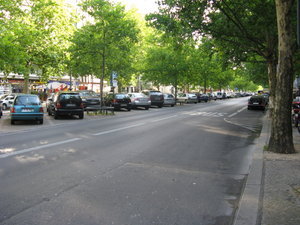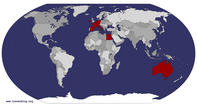Advertisement
Published: October 24th 2008

 A Berlin Street
A Berlin Street
The street outside the hotel.I woke up at about 7am, still onboard the train. The previous night when I looked out the back of our carriage, all I could see was the carriage behind us. After I got up and looked again, all I could see was railway tracks going by. After a while it dawned on me that we may have lost some passengers along the way. It then all made sense ... I remembered waking up in the middle of the night and noticed that we weren't moving. I hope those passengers knew which carriage they were meant to get on, or else there are some really cranky people somewhere between Brussels and Berlin.
I had a lot of fun on the train, simply because it felt like a really posh cubby house. I wouldn't like to do too many trips like that, but as I got the top bunk (of three) I got to do a bit of a contortionist act to get into bed. As I have said all along, it's all part of the experience.
We arrived at Zoo Station and caught a city bus to our hotel. I say hotel, but it was called a pension, which
I think means boarding house or small hotel. It was on the fourth floor of a building, and I think it has been converted from a set of appartments into the hotel. As Mark (my roommate) and I were the only males in the group, we obviously got our own room. It was a really large room, and the shower and toilet was across the corridor. The bathroom was actually bigger than the other hotel rooms I had been in, and was assigned only to the two of us. This is were I feel a bit bad. Four of the ladies had to share one large room, but their bathroom (make that simply a shower) was in their room. And it didn't have any door. Ah, the luck of the draw I suppose.
Once we were settles in, most of us went on an organised walking tour of the main parts of Berlin. We were guided by Torpend, an American who is now a German citizen. He spoke incredibly well, and had all the history and other information to make the walk really worthwhile. We went by some museums, then to Bableplatz, a square where the book-burnings of May
10, 1933 occurred. They have now built an inaccessible underground room at the site, which contains enought empty bookshelves to hold the estimated 20,000 books that were burnt across Germany that night. The room is covered with glass, and can easily be missed if you aren't aware it's there.
We then went near the Brandenburg Gate, but as there was a large demonstration happening at the time, we couldn't actually go under it. The gate was built at the end of the 1700's, but during the time of the Berlin Wall, it was situated in the no-man's zone of East Berlin. It's interesting to see how much rebuilding has happened in recent years, and how much the Germans show their commemoration of the past, but also their acceptance to learn from it. Down the road from the Gate is Potsdamer Place, another landmark that ended up in no-man's land and therefore neglected for nearly thirty years.
Next was the Holocaust Memorial. It is a series of variying sizes of large concrete blocks, covering the area of about one city block. There is nothing written on the blocks, and nothing is really seen that indicates what the monument means.
I guess it is designed to make people think about the issues and decide what the momument means to them.
We then stopped at dirt carpark that wasn't all that interesting. We were then told that it was the sight of Hitler's bunker and were he died. There is a single sign erected near the site that gives some detail about the bunker and how large it was. After the war the Soviets blew up the complex, so nothing remains to be seen. It was a bit strange to be standing on the site of such a notorious complex, but in a way I was glad to see that there wasn't any massive recognition or exceedingly large monument. It was another way that the Germans are simply getting on with things while still acknowledging the past.
There are a few places around the city that still have sections of the Berlin Wall still standing. The actual line that it took along the road is gradually being marked out with a series of pavers to indicate just how divisive the Wall was. To realise that it ran straight through the middle of roads and buildings that were, at that

 The location of the former Wall
The location of the former Wall
The route of the Wall is being marked.time, being used for everyday life, is quite thought-provoking. We were told of Subway stations that were in East Berlin territory, but East Berliners were no longer able to access them. However, they could still hear the trains operating underneath, as West Berlin still needed to use the lines to operate their own trains.
The last stop on the walking tour was Checkpoint Charlie. This is the most famous border crossing, and there is now a tacky replica of the original buildings. There were many attempted crossings of the border at the point, some successful and some not so successful. The most notable is that of Peter Fechter, an East German teenage who, in 1962, was shot in the back by soldiers while trying to cross the border. There was a standoff of soldiers from both sides for about an hour. Meanwhile Mr Fechter was lying on his own in no-man's land bleeding to death. No one was game to approach the shot man for fear of provoking the other side. In the end Mr Fechter died before he got any help, and I think this illustrates how political the whole situation was.
That evening we went to
a German restaurant for a meal. I don't normally write down what I ate, but this time I felt it was worth it. There were frankfurters with bread, meatballs in caper sauce with beetroot and potato, followed by some Apple Strudel. And the size of the meals were quite large too. It certainly filled me up, but was also very tasty. One of the things on the menu was a cabbage stuffed with a type of mince, with the cabbage being at least 1kg in weight. One of the girls in the group manage to get through the 500g version, and although it was tough going for her, she said it was really yummy.
The next day I got on the train and went out to Potsdam, about 20 minutes out of Berlin. It is a nice small town, with a few old palaces from the time on the monarchy. One of the residences is call Schloss Cecilienhof, a building from about 1918. It still operates as a hotel today, and was used for the Potsdam Conference in 1945. This was where the British, American and Soviet leaders met to organise the post-war conditions of Germany.
As Potsdam

 Schloss Cecilienhof, Potsdam
Schloss Cecilienhof, Potsdam
I'm not sure if they intended the roof to look like a face, but I thought it was a cool pic.was in the former East Germany, there are still many monuments and buildings remaining from that era. I came across a cemetery which was dedicated to, what looked like, Soviet soldiers. Although I can't read Russian, the dates on the gravestones seemed to show that they died in 1945 and 1946. It really got me interested, but unfortunately I couldn't find out more about it.
The following morning was the end to the Intrepid tour, and after saying goodbye to the group I went across town to my hotel on the East side. The difference between the two sides of town is stark, and in terms of 'architectual flamboyance', the West side wins hands down. I then went straight back across town to the Berlin Zoo, where there is the largest amount of species of any zoo in the world. The first thing I saw were the elephants, munching away on their morning snack. I counted about six elephants in total, including a very cute little baby. I was watching one of them for about 15 minutes while it sucked up soil with its trunk and blew it all over its body. I'm not sure why they do that,
but it was awesome to watch how they used their trunks for so many different tasks. A man then walked up to watch the same elephant, and quick as a flash the pachyderm turned around and sprayed him with a full nose of dirt. It may have been the red cart he was pushing, or the elephant just saw something that he didn't like. Either way, it was one of the funniest things I had seen in a long time. I'm just glad that it didn't happen to me.
The rest of the zoo had an incredible number of animals. I won't list them all, but anything you would expect to find, they had it. And yes, they even had some kangaroos and emus. I spotted some polar bears, but little Knut wasn't one of them. Maybe he was having his midday nap. I had a really good time there, and would really recommend anyone to go for a visit.
The next day was a milestone for me. It was the first tiime on my trip that I needed to buy an umbrella. I figured it was a good time to do some indoor stuff, so I headed
to the Pergamon Museum. They had an exhibition on Babylon, and lots of artefacts to go with it. I wasn't all that fussed with it, but it may have had something to do with the huge number of people I had to wade through in making my way around the place. When I left there at midday the rain had eased a bit. I decided to do the circuit of the famous landmarks like the Brandenburg Gate, the Reichstag and parts of the Berlin Wall. I was glad I got to walk around a second time by myself, as I good really take it all in and read what it was all about.
The other thing you see around the city are large coloured pipes snaking their way around the streets. These are apparently from constructions sites, with water being pumped through them away from the diggings. Berlin is built on swamp land, and any major holes that are dug will fill with water.
I really enjoyed my stay in Berlin, and it was pretty much what I had expected. Its recent history dominates what you see, but there are many beautiful parts to the city. Next stop is

 Segments of the Berlin Wall
Segments of the Berlin Wall
Notice the pile of chewing gum on the side. Dresden.
Advertisement
Tot: 0.144s; Tpl: 0.013s; cc: 8; qc: 61; dbt: 0.1065s; 1; m:domysql w:travelblog (10.17.0.13); sld: 1;
; mem: 1.2mb













